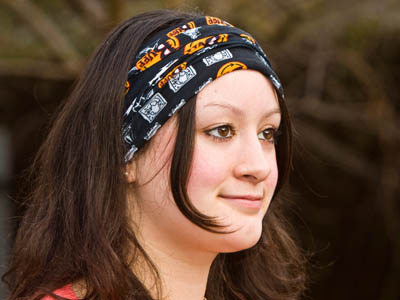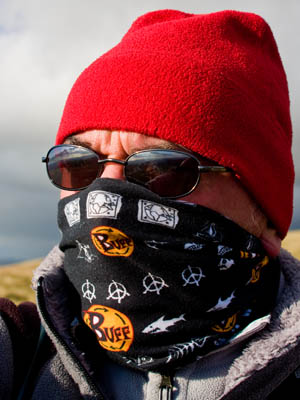
Runner Lisa Campbell models the Original Buff
On test: Original Buff/Polar Buff
I must admit, that when I was first handed a circular piece of light, patterned material known as a Buff, and asked to ‘try it out’ I was a bit bemused as to where to start.
It is certainly the first, and only, accessory I have ever owned which requires a 10-minute DVD demonstration before you have a clue how to wear it – or progress from an Indian-chief style band-around-my-forehead look.
But from starting out with a rather giddy attitude towards my new fashion toy, I soon realised that the strip of material was actually a bit of a miracle-worker.
We get all sorts of weather on this island, and the Buff is surprisingly adaptable in most conditions. In harsh wind while exposed on a mountainside for example, it can be worn as a shield around the mouth and nose. When the sun is beating down on the beach after a dip in the sea, it can magically become a trendy and protective sun cap.
And if the weather suddenly changes after you have already decided upon your Buff-look for the day, the headwear is designed to move lucidly from one style to another, without the fuss and faff or getting out a pocket mirror to check it’s on the right way or not back to front or inside out.
Even if the weather stays constant, it is not to say body temperature will, as those used to hillwalking or fellrunning will be aware. As you heat up or cool down, a Buff is also handy as a neckerchief to add extra warmth, or as something to mop up sweat from a brow, when it would usually drip straight into your eye.
Caught in a rather unladylike situation, I found my Buff a lifesaver during a race with no tissues and an increasingly runny nose. The dilemma was, continue the run looking like I’ve eaten a vindaloo or use the Buff to take all visible symptoms away. It was an easy choice.
And for those who would feel too bigheaded to go around boasting to the world ‘I ran the Three Peaks!’ a Buff can also be a prideful badge of honour, as many can be bought with race signature on it, too.
For my last adventure with the Buff, a chef friend of mine had suggested he could use one in the kitchen, complying with hygiene regulations about hair-exposure and maybe even attracting more waitresses than he does wearing a net.
So, with this in mind, I got out my dinner party cookbooks, and although enough of a sweat wasn’t worked up to warrant wearing one, I did get some compliments on my rather ‘bohemian’ outfit for the evening.
Bob Smith adds:

The Polar Buff: don't try this in the bank
Let me make it clear: unlike my colleague Ms Campbell, I’m not a runner. The clang of the last-orders bell is the only thing that gets me up to anything like a trot. But I do spend a lot of time plodding up big hills at the lower end of Tranter’s impossibly complicated variations to Mr Naismith’s simple rule.
So my task was to test the heavy-duty version of the Buff: the Polar Buff which, in addition to the standard bit, has a Polartec fleece section at the bottom. It comes into its own during the colder winter months, when extra warmth is called for.
For a simple piece of relatively cheap kit, it is, as Lisa intimated, very versatile. So versatile that it has an instruction DVD to refer to.
I found myself making sure it was in my rucksack every time I hit the winter hills. It’s very light, takes up hardly any space, and has insinuated itself into the ‘must’ list of contents of my pack.
Mostly, I found simply using it as a sort of scarf for much of the time. It keeps the cold and wind from the neck area. In fact, there were times when, even in the arctic conditions of some serious windchill, I found myself overheating in the neck area as I tackled a steep ascent.
That said, it came into its own in cold, windy conditions. Not only does it protect the neck, but it can be pulled up to cover the mouth and nose and keep off the worst of a biting mountain wind. I often used it in combination with my trusty fleece hat to keep my ears warm too.
Where it doesn’t score so well is in wet conditions. The Buff quickly becomes sodden and, though it will squeeze out like all microfibre and fleece, it is certainly not water resistant.
Having said that, it does retain body heat, even when wet, so I still found myself using it even in typical torrential fell conditions.
You do find yourself wondering what other passing walkers think of this man who looks like one of Jesse James’s gang, just the eyes peering out above the bank-robber mask. Best to drop it back down to your neck before you pop into the Clydesdale in Fort William to make a quick withdrawal.
The Polar Buff does function quite well as a hat too, as long as you can remember the instructions, and for fashion victims it can be turned into a bandana.
All in all, a useful piece of gear to have with you.
Unusually for most outdoor clothing, the Buff is made not in the Far East, but in Igualada, near Barcelona.
The Original Buff sells for £13.00 and the Polar Buff costs £23.00.
The Buffs were supplied free of charge to grough by Buffera Ltd for testing.